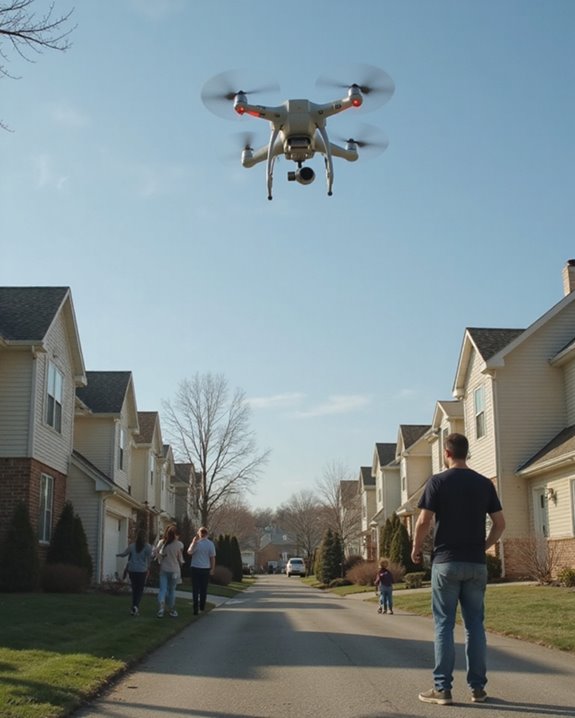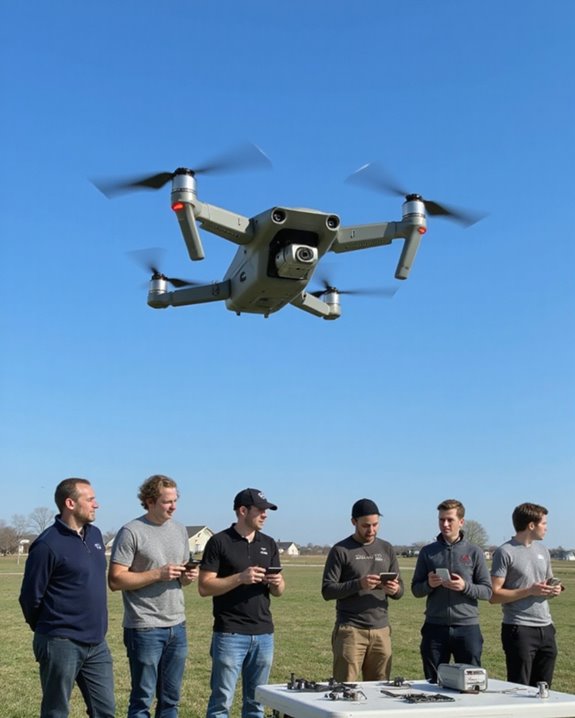Drona, in the famous Mahabharata tale, asked Ekalavya for his right thumb as guru dakshina—a bold move that left everyone shocked! Imagine training so hard, only to be asked for something essential to your skill. This life-changing request, often discussed in school textbooks and plays like “Ekalavya: The Forgotten Hero,” wasn’t just about archery; it sparked debates about fairness, favoritism, and sacrifice in ancient India. Want to uncover more about how this shaped Indian legends and values?
Key Takeaways
- Dronacharya asked Ekalavya for his right thumb as guru dakshina (teacher’s fee).
- The right thumb was crucial for archery, effectively ending Ekalavya’s potential as an archer.
- Drona’s request was motivated by favoritism toward his royal student, Arjuna.
- Ekalavya willingly cut off and offered his right thumb as a mark of respect and devotion.
- This act is often debated for its ethical implications and symbolizes sacrifice in Indian lore.
The Encounter Between Drona and Ekalavya
Even though ancient India’s forests were teeming with wild animals and mysteries, perhaps nothing was quite as surprising as the moment Drona and his royal students stumbled upon Ekalavya practicing archery there! This Forest Encounter was more than a chance meeting—it was a collision of worlds. Ekalavya, son of a Nishadha chief, greeted Drona with deep respect by prostrating at his feet, calling him “Guru.” The royal students, especially Arjuna, watched in disbelief as Ekalavya demonstrated astonishing skill—he could shoot arrows into a dog’s mouth without injury! The event’s Cultural Symbolism was powerful: here was a boy from a “low” tribe, mastering archery through sheer will and a clay idol, quietly challenging the very social order those forests were meant to protect.
The Tradition of Guru Dakshina in Ancient India
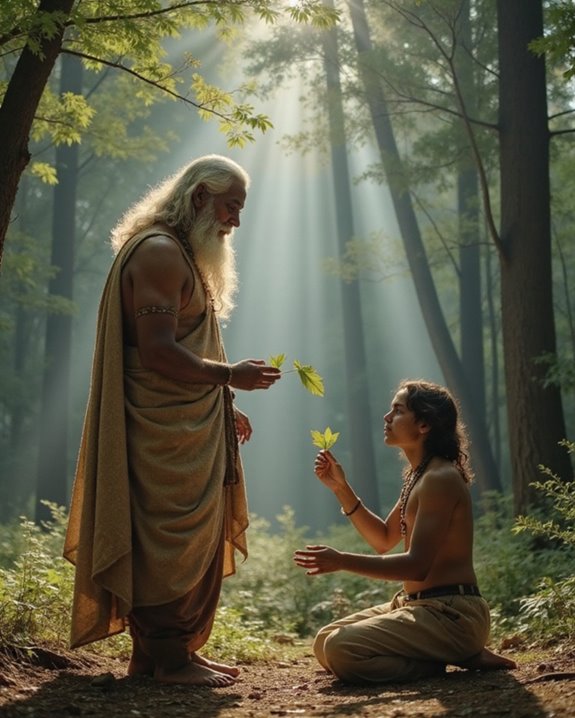
A fascinating part of ancient Indian education was the tradition of Guru Dakshina—have you ever wondered what a “thank you” looked like before greeting cards and cell phones? In those days, students practiced Equal Residency by living together in their guru’s home, working, learning, and sharing chores, whether they were princes or potters’ sons. The guru wasn’t just a teacher; he was like a second father, and his wife was everyone’s “gurumata.” When education ended, students offered Guru Dakshina—a Voluntary Offering that could be anything from helping with daily tasks to fetching rare herbs. This gesture wasn’t about the price tag; it was about gratitude, respect, and bonding. Sometimes, the request was surprising—just ask Ekalavya! The tradition endures, reminding us that gratitude never goes out of style.
Ekalavya’s Unique Path to Mastery in Archery
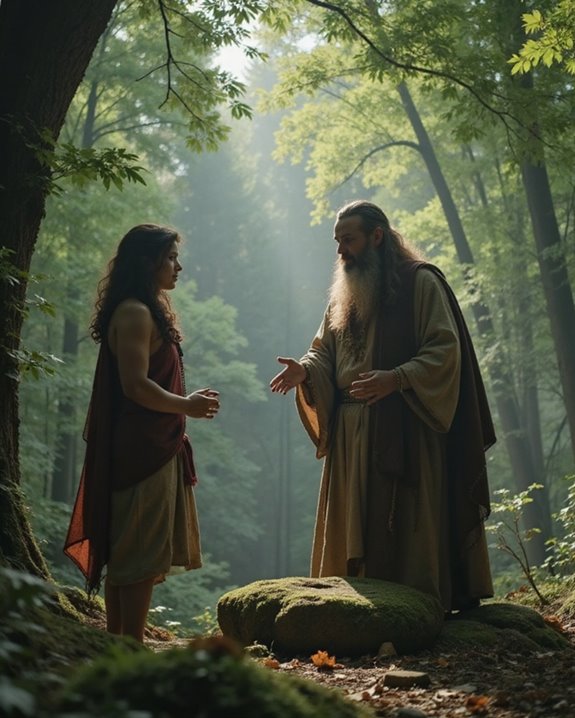
How does someone become a legendary archer when the world says “no”? Picture Ekalavya, deep in the forest environment, surrounded by trees and wild animals, where his journey began. Rejected by Dronacharya because of social barriers, Ekalavya didn’t quit—he got creative! Using self learning methods, he sculpted a clay statue of Drona and practiced in front of it every day. No YouTube tutorials, just pure determination and the rustling sounds of the woods for company. His practice paid off; Ekalavya’s arrows could silence a barking dog without causing harm, a feat that even amazed seasoned warriors. This unique path, fueled by devotion and clever self-teaching, made Ekalavya not just skilled but truly legendary—proving brilliance can bloom even in the wildest places!
Drona’s Promise to Arjuna and Its Consequences
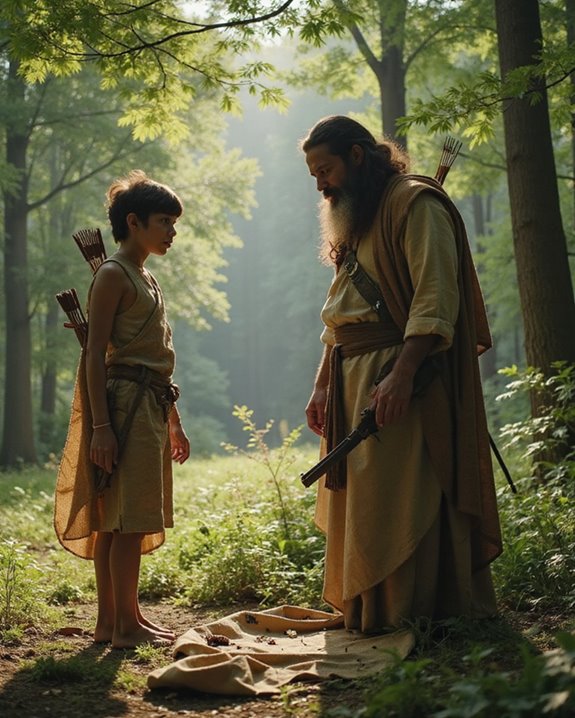
While Drona’s promise to Arjuna sounds like the start of a heartwarming teacher-student story, it actually sparked some serious drama in the Mahabharata! By vowing to make Arjuna the greatest archer, Drona set the stage for epic Arjuna’s Rivalry with other talented warriors like Karna. Suddenly, every lesson and tournament became a contest, with Drona’s favoritism casting a long shadow. Drona’s Promise Legacy wasn’t just about one student’s success—it created envy, political tension, and a lot of awkward family dinners in Hastinapura! Other students, including princes, felt sidelined as Drona reserved secret weapons and special techniques just for Arjuna. This promise shaped Drona’s teaching style and even his wartime strategy, making him both a legendary mentor and a controversial figure!
The Request for Ekalavya’s Right Thumb
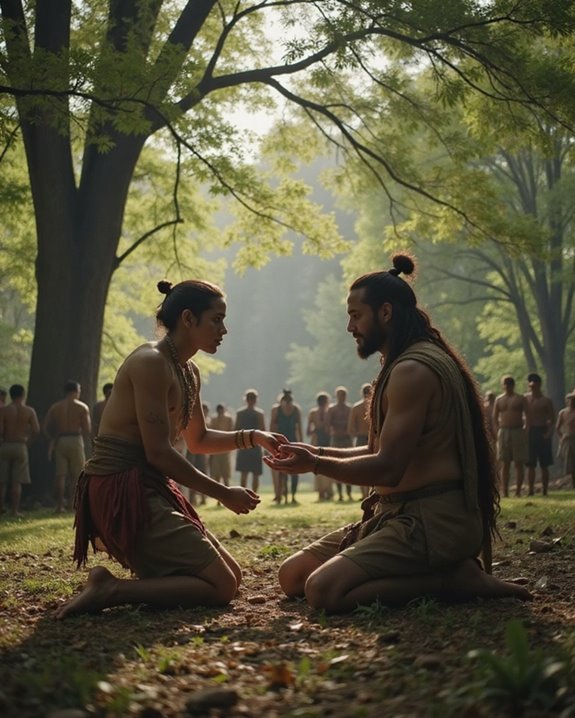
Imagine this—Ekalavya, a dedicated and self-taught archer from the Nishada tribe, stunned everyone with his skill, all thanks to his intense admiration for Dronacharya. When Dronacharya saw Ekalavya’s remarkable archery, he made a surprising request for guru dakshina: Ekalavya’s right thumb! Why the thumb, you ask? Its anatomical role in archery is huge—it’s the MVP for gripping bowstrings, aiming, and, well, pretty much everything an archer does. Without it, even Robin Hood would be in trouble! Historically, there are parallels in many tales where a prized skill is taken away for social or personal reasons. Dronacharya’s request, driven by favoritism toward Arjuna, changed Ekalavya’s fate, highlighting both the power dynamics and the importance of the thumb in ancient Indian culture.
Ekalavya’s Expression of Devotion and Sacrifice
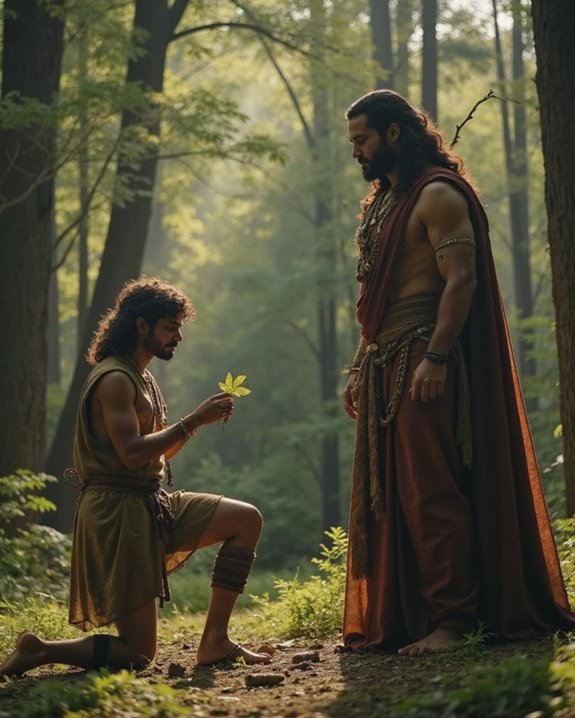
Even in a world where legends are born on the battlefield, Ekalavya’s act of slicing off his own right thumb stands out as a jaw-dropping declaration of devotion! Imagine giving up your greatest skill as part of Devotion Rituals—now that’s commitment. In the Mahabharata, Ekalavya’s sacrifice wasn’t just about following orders; it was a powerful Sacrifice Symbolism, showing absolute loyalty to his guru, Drona. This story highlights the traditional Guru-Shishya bond, where the student’s duty sometimes demands heart-wrenching choices. Ekalavya, self-taught and undeterred by social barriers, became an inspirational figure—his determination and unwavering devotion have echoed through centuries. His action is a classic example of self-denial in pursuit of knowledge, a theme that continues to inspire and challenge readers today!
Impact of the Sacrifice on Ekalavya’s Abilities
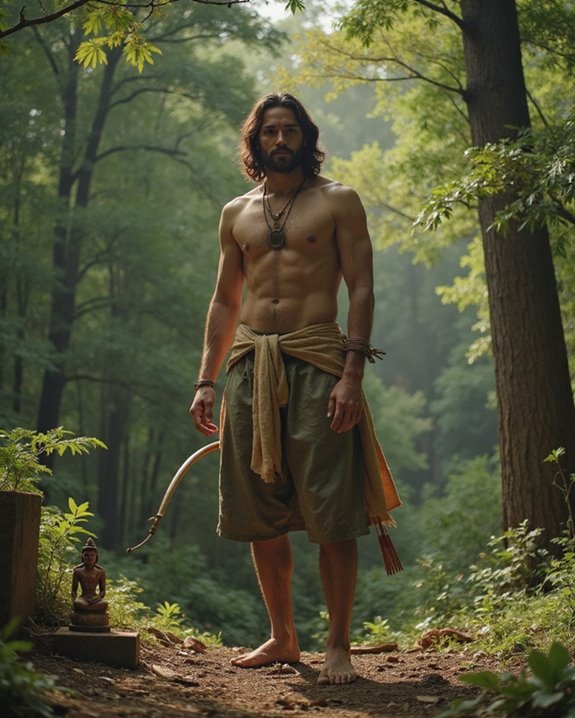
Ekalavya’s awe-inspiring act of devotion wasn’t just a storybook moment—it had some pretty serious consequences! When he gave up his right thumb as Guru Dakshina, the Physical Impairment was immediate and drastic. Without his thumb, Ekalavya could barely draw a bow, let alone shoot with his old speed or accuracy. His legendary archery skills? Gone in a snap—literally! But the real challenge was Psychological Adaptation. Imagine training your whole life for something, then losing it overnight. Ekalavya faced trauma, grief, and a deep sense of loss, wrestling with his shattered identity as an archer. Yet, his story also sparks admiration for his resilience, as he was forced to adapt emotionally and mentally, even when the odds—and perhaps the universe—seemed stacked against him.
Ethical Dilemmas Surrounding Drona’s Demand
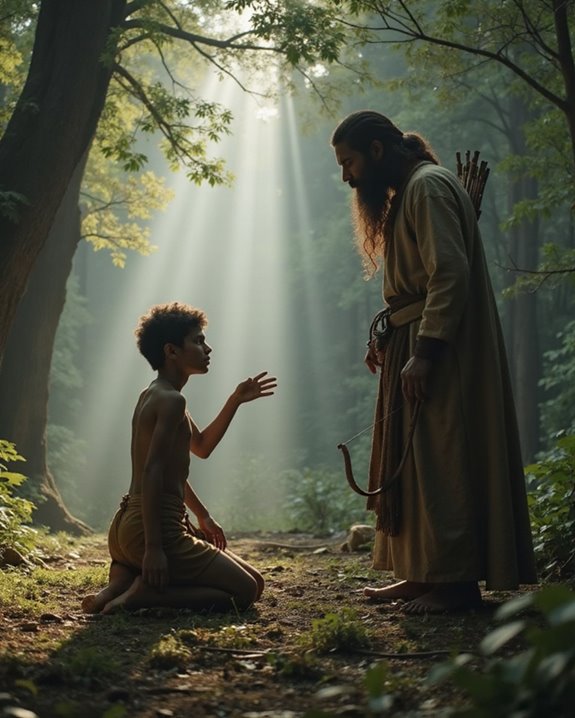
How does a teacher’s promise to one student lead to an act so controversial that it still sparks debates today? Dronacharya’s demand for Ekalavya’s thumb, offered as guru dakshina, is full of ethical dilemmas. There’s an obvious Ethical Bias—Drona, trying to keep his promise to Arjuna, asks Ekalavya for a sacrifice that ruins the young archer’s future. The impartiality concerns are hard to miss! Why should one student’s ambitions mean another’s talents get cut short, quite literally? The Mahabharata doesn’t shy away from calling Drona’s move harsh, even hinting that he abuses his power as a teacher. Readers see favoritism, not fairness, and the ancient epic gives us a timeless lesson: teachers must choose justice over personal alliances, even when it’s tough!
Cultural and Social Implications of the Story
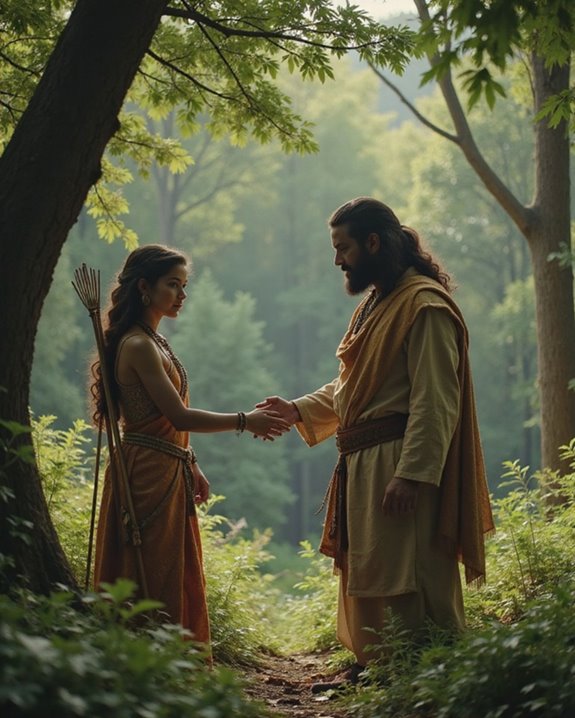
Step into the world of the Mahabharata, and you’ll quickly see that Ekalavya’s story is much more than just a lesson in archery—it’s a powerful spotlight on India’s ancient social rules! Ekalavya’s sacrifice of his thumb reveals the harsh reality of caste supremacy and social hierarchy, reminding us that talent often got sidelined by birth, not ability. It’s like the world’s most unfair club, and the bouncers are really strict! Modern relevance pops up as people today still debate identity politics and access to education, drawing inspiration (and sometimes frustration) from Ekalavya’s fate. Artistic works—from classic Sanskrit dramas to colorful paintings—keep retelling his story, exploring themes of loyalty, discrimination, and power. The message? Social exclusion hurts everyone, not just Ekalavya.
Lasting Legacy of Ekalavya’s Guru Dakshina in Indian Lore
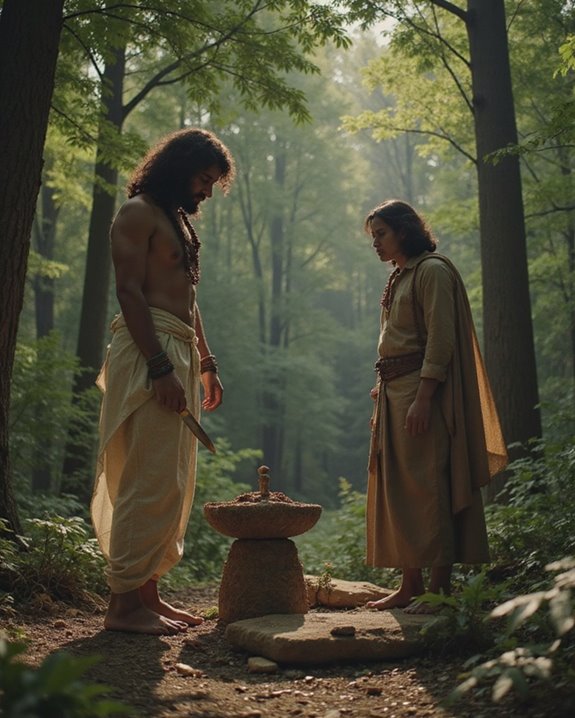
Legends from the Mahabharata never really go out of style, and the story of Ekalavya’s guru dakshina is proof! You’ll see his tale popping up everywhere—from school textbooks to plays like “Ekalavya: The Forgotten Hero.” It’s not just about archery; it’s about big ideas like sacrifice, social equality, and the right to learn. Philosophical debates about duty and fairness still spark from his thumb’s sacrifice—was it right, was it cruel, or both? Teachers use Ekalavya’s story for its educational value, reminding students that true mastery sometimes means learning on your own, no fancy academy required! Even today, artists draw Ekalavya as the face of humility, and movies revisit his resilience, showing how his legendary act continues to inspire and challenge India’s values.
Frequently Asked Questions
Was Ekalavya Ever Reunited With Drona After the Incident?
Regarding Ekalavya’s reunion with Drona, major sources do not mention any such event. Reunion theories and forgiveness speculation exist in later interpretations, but traditional texts remain silent on any direct encounter or reconciliation between them.
Did Ekalavya Participate in Any Battles After Losing His Thumb?
Much like legendary warriors who adapted after tribulation, Ekalavya displayed remarkable archery adaptation. His battle exploits continued post-injury; despite losing his thumb, he participated in combat, maintaining significant prowess and confronting formidable foes, including Krishna himself.
Is There Any Historical Evidence That Ekalavya Really Existed?
There is no archaeological evidence confirming Ekalavya’s historical existence. His story relies primarily on textual sources, particularly the Mahabharata and Puranic literature, making him a legendary rather than verifiable historical figure in Indian tradition.
Are There Other Stories of Guru Dakshina Similar to Ekalavya’S?
Nearly 70% of Indian epics feature scenes of guru dakshina, illustrating its significance. Ancient myths and cultural parallels abound, such as Rama protecting Vishwamitra’s yagna, highlighting sacrifice, loyalty, and the profound bond between guru and disciple.
How Is Ekalavya Remembered or Honored in Modern Indian Culture?
Ekalavya is remembered in modern Indian culture as a Cultural Icon, inspiring educational initiatives, awards, and community programs. Artistic Depictions in literature, visual arts, and performances celebrate his devotion and resilience, highlighting ongoing discussions on social justice and equality.


